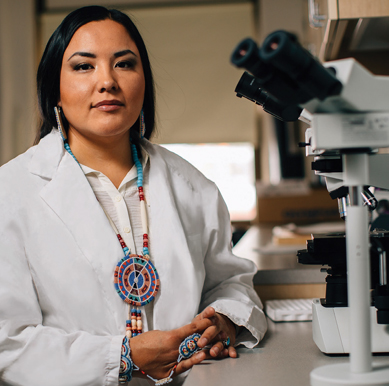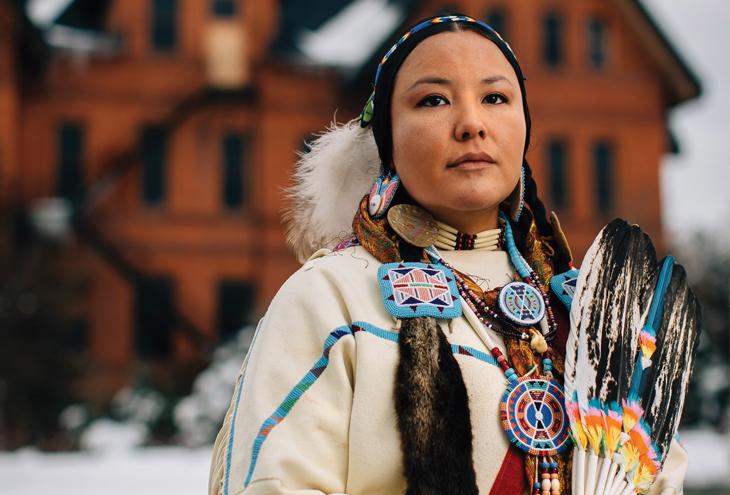Trisheena Kills Pretty Enemy
Crow And Hunkpapa Lakota
Montana State University
Microbiology
When I was six years old, my older sister bought me a toy microscope. The first thing we did was prick her finger so we could look at a drop of blood under the microscope. I can still remember that first feeling of infatuation with the world of the unseen, the micro world, and was astonished by what I now know as red blood cells. It was at this young age that I fell in love with science.
Growing up on the Crow Reservation in Pryor, Mont., allowed me to further my interest in science and biology throughout my childhood. My family lived just outside town, closer to the mountains. I spent my summers playing outdoors and swimming in the creek, learning to appreciate nature and the world around me. I used to take my microscope outside with me to look at different plants and bugs, and I was blown away by what I saw.
My interest in science grew when I got to high school. My biology teacher taught with such passion and enthusiasm that it made learning fun, and I became fascinated by the unseen world all over again. During high school biology I really began to think about a career, and I knew that my future involved the biomedical field.
The end of high school proved challenging, though, as my father was diagnosed with an autoimmune liver disease. We spent my junior and senior years shuttling him eight hours back and forth to his medical appointments, and trying not to notice that his health was quickly deteriorating. Both my parents had always stressed the importance of getting an education and being able to support ourselves. Seeing my dad so sick only reaffirmed my desire to pursue a degree.

I feel like I’ve found a good balance between my Native American interests and my scientific interests.
While I was getting my associate’s degree at Little Big Horn College, my dad became terminally ill. It filled me with an overwhelming sense of determination to finish school, become a doctor, and conduct research that would benefit my dad and my people. Thankfully, my dad was able to watch me receive my associate’s degree, and he saw me off to college at Montana State University, where I started in the fall of 2014.
During my first semester in college, my father passed away. I was devastated. Dealing with his death while also a full-time student was difficult. To complicate matters, I was also juggling being a mother to two young sons — a toddler and a preschooler. Thankfully, MSU was always there to support and encourage me.
Once I found my footing, I became immersed in my classes. In one, Introduction to Native American Studies, we learned about Native history and the genocide this country was built on. It saddened me to learn about such a dark time in America’s history — but it also empowered me to learn about Native resilience. When I go through hard times, I think about what my people have overcome.
I used the strength I gained from this class to determine my major: microbiology. I’m fortunate that I had a variety of experiences both before and during my time at MSU that have helped me shape my path. While getting my associate’s degree, I worked with a professor to study E. coli in the Little Big Horn River. Rivers are a sacred part of the Crow culture, and being able to intertwine my culture and my scientific curiosity led me to channel my love for science into a passion for research.
This research opened my eyes to a new career, and I decided to pursue more research opportunities. I participated in Bridges to the Baccalaureate, a Montana program that helps students transition from tribal colleges to four-year universities, and began doing research studying the molecular epidemiology of Clostridium difficile infection. I also spent the summer of 2017 in Salt Lake City, Utah, as a participant in the Native American Research Internship program, studying the congenital heart defects of zebra fish.
Each of these experiences has been a steppingstone toward a career in scientific research, and together they’ve fueled my enthusiasm. Now, I’m a senior and expect to graduate next spring. I feel like I’ve found a good balance between my Native American interests and my scientific interests. I am currently a mentor to two Native students in STEM, the vice president of our AISES Chapter, and a member of the American Indian Council. And I was recently selected to represent MSU at the 42nd annual American Indian Council Pow Wow as head woman dancer.
I’m still considering what my next move will be after graduation. I used to get angry when people would comment on my last name, but now I’m proud and excited to be the future “Dr. Kills.” Whether I end up going into medicine and return home to help my community, or go to graduate school and into academia to teach students like me, I know I want to help people.
My path hasn’t been easy, but I wouldn’t change it. I know that a major factor in my success has been my perseverance and resilience. Having support from my family and teachers has also been essential in helping me get to where I am today. As Native Americans, we have fought like heck to be here, and have encountered many setbacks along the way. I fight against the odds to honor those who have passed. Remember, you are not less than, you are more than. We have an opportunity to make a difference in our community, and we will.













